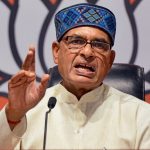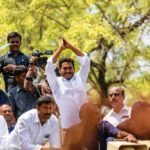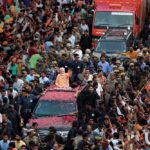Varanasi: The City of Flickering Light
In the 2014 elections, Shylashri Shankar found Varanasi under the spell of Narendra Modi. Revisiting it in the current campaign, she finds some change is evident but the fault lines underneath remain the same
 Shylashri Shankar
Shylashri Shankar
 Shylashri Shankar
|
08 May, 2019
Shylashri Shankar
|
08 May, 2019
/wp-content/uploads/2019/05/Varanasi1.jpg)
IN 500 BCE, WHEN BUDDHA CAME TO THE CITY at the confluence of Varuna and Assi rivers, Kashi was already an ancient settlement, a contemporary with Babylon, Nineveh and Thebes. Benares (during British rule) or present-day Varanasi is the birthplace of Kabir and Ustad Bismillah Khan (whose son is Narendra Modi’s sponsor in the nomination papers). Tulsidas wrote the Ramcharitmanas here, and Sage Vyasa dictated the Mahabharata to Lord Ganesha on the banks of the Ganga. And now Varanasi is the constituency of Prime Minister Narendra Damodar Modi.
That’s where I was headed and my visit coincided with Modi’s nomination visit. I was in Benares to see the Modi effect—what makes him popular (he won in 2014 with 53 per cent of the vote share) and what has he done in the city? In 2014, I watched Aam Aadmi Party chief Arvind Kejriwal and Modi file their nomination papers. Then, the mood was buoyant. Though many predicted Modi’s victory, Kejriwal had a committed cadre of supporters among shopkeepers and Muslims who were enthusiastic about his promises to remove corruption and be a representative who would take their grievances to Parliament.
“Aasman saaf hai, havaa shaant hai (clean sky, still air),” announced the pilot. Our drive to the hotel took 40 minutes on a newly minted road; no traffic jams at 10 am. One of Modi’s 2014 promises included more connectivity for the city dwellers, the others being cleaning up the city and the Ganga, and more quality raw material and better marketing for weavers. A new Ring Road-Phase I has reduced traffic congestion in the city. We were, however, stuck in a jam for an hour on the third day in Ramnagar.
DAY 1: ARRIVED AT THE Taj Ganges and discovered that it was the epicentre of BJP activity. Two dozen or more saffron kurta and pyjama-clad party leaders, Uttar Pradesh ministers and their staff, the press, and uniformed commandos were ensconced in the small lobby, waiting to receive BJP chief ministers and central command leaders including Sushma Swaraj, Piyush Goyal, Rajnath Singh and Amit Shah. The BJP cadre were staying at the Radisson hotel.
Our first port of call was Ajay Rai, a five-time Member of Legislative Assembly (MLA) with the dubious distinction of having been a candidate from the BJP, then the SP and now the Congress. If Priyanka Gandhi did not contest here, Rai would.
A gunman emerged and took us to a large room with granite floors and leather chairs and sofas. My notes from the previous interview with him in 2014 said, ‘Congress leader whose brother was killed in gang warfare with a Muslim gang.’
“How is Modi’s campaign different from last time?” I asked.
“Modi got his vote last time as a PM candidate, but this time he is the PM, and he is asking for votes after having broken the heart of Benares—the Kashi Vishwanath temple.”
This was going to be his election issue.
“Weren’t the encroachments cleared to make a path to the Ganga?”
“No encroachment,” he snapped. “The houses were built to hide the temple from Mughals. They contained old idols. All destroyed now. Modi had given the contract for the project to an outsider, an Ahmedabad-based company also involved with beautifying the Sabarmati river.”
I couldn’t see many takers within Benares—to demolish temples in a temple town would invite the wrath of Shiva, who is supposed to have established the city.
Then he struck with a zinger: “Modi came as a dharm bhakshak (eater), not a dharm rakshak (saviour).”
“Will Priyanka be contesting from here?”
“Everything will be made clear today,” he said. “If she contests, she will win.”
“But how?”
“Last time Modi won with five lakh votes, but not this time. Modi won’t have the support of RSS this time. They are very angry about how Brahmins have been shunned by Modi. A party that came to power using the temple and religion is the same one that is demolishing temples here in Benares,” he said. “I am sure we will win.”
“Sure?”
“Sure. Lock kar lijiye.”
In the car, a news flash appeared on my mobile. Ajay Rai has been made the Congress candidate from Varanasi.
WE HAD A simple lunch. The hotel lobby was packed with the reception committee for Modi, who was due to begin the rally at 3 pm from Banaras Hindu University (BHU).
So far, there was little to distinguish the BJP from the Congress. Courtier cadres and the heads behaving like kings. Very few women were visible among the political cadre.
BHU campus: 2.20 pm
With police barricades going up a kilometre from BHU, we had to find a back gate into the campus. We passed hostels named after ancient rivers—Ganga, Godavari, Narmada—and arrived at the main gate where a carnival was underway. A Modi carnival.
The disciplined cadres of Akhil Bharatiya Vidyarthi Parishad, an RSS-affiliated student wing, were already marching and shouting slogans to the beat of drums and dholaks. Saffron Gandhi caps with catchy slogans—Is baar bhi Modi sarkar—and white T-shirts with saffron writing. We walked about 20 yards to the Madan Mohan Malviya statue outside the main arch of the university where Modi was due to arrive.
The sun had a peculiar piercing intensity, the kind that makes your skin sizzle. But it did not dampen the ardour of the Modi brigade. Mostly youthful faces, directed by middle-aged pehelwaans.
A tall man in his early thirties, with a calm face and spectacles, identified himself as a social worker. Yes, he was from the RSS. I asked if the RSS was annoyed with Modi for creating the Kashi Vishwanath temple corridor.
No, he said that wasn’t true. Only the encroaching houses had been razed.
Surely the temples hidden inside the homes too were demolished.
He smiled and said, “If you remove the hair on my scalp, sometimes you may injure my scalp. That is what happened.”
A burly chap was exhorting the troops: “You are not here to just shout slogans. You are here to protect the country. You… ” He broke off mid-sentence and asked one of them, “Hey you, are you chewing paan?” The culprit nodded.
“Do not spit it out. Nobody must spit the paan out. Swachh Bharat is our motto.” The battalion took up the chorus.
The RSS worker talked about how clean the city was thanks to Modi. “Modi has united the people,” he said.
Around what cause? Swachh Bharat?
“No, that is a different programme. He has united the people. If I say the cause, you will start asking questions and we will start debating.”
He meant Modi united ‘the Hindu people’ and I knew it. So do Muslims. When we went later to a weaver’s locality where everyone was Muslim, and asked a group sitting in a tea shop about their views on Modi, a chap in his late twenties said, “We are voting for Modi.”
“Really?”
“Yes, we are all voting for Modi. He is showing us a very great glimpse of our future.”
“You are being sarcastic.”
He smiled and so did the others and then yelled, “Modi.”
Varanasi’s relentless heat sucks you in, with the air heavy with pollution and constantly in vibration to the temple bells, and the crowds infusing energy, fervour and intensity
WHILE I WAS conversing with the RSS worker, a 24-year-old mathematics graduate now studying for the Union Public Service Commission (UPSC) exams, piped up in response to my question about Modi’s popularity. He said people were voting for Modi not because of Modi but because there was no viable alternative. For him, and others he had spoken to, Rahul Gandhi was not a viable choice. He said he was at the rally because he was angry.
About what?
“The reduction in the number of civil service positions.”
What does Modi say?
“Nothing. He is silent.”
“Ask him,” I said, indicating the RSS worker.
The student did.
The RSS worker spoke about Swachh Bharat and infrastructure.
The student said, “You did not answer my question.”
The RSS worker walked away.
I asked the student whom he would vote for.
“I voted for Modi in the last election,” he said, “but in this one, I will vote NOTA.”
A Rapid Action Force commando spoke in Tamil to his colleague. I asked him in Tamil about the impact of the Pulwama attack and the Balakot response on the morale of the army. “They approved,” he said and then volunteered that Modi was a strong leader.
The NOTA or ‘none of the above’ vote is of concern to the maulvis of the large mosques in Varanasi. One imam said he is telling his flock not to waste their vote and to vote for either the SP-BSP combine or the Congress. In the 2014 elections only 0.71 per cent (12,201 voters) opted for NOTA in the Varanasi constituency. This time it is Modi who will benefit from it, while his opponents will be hurt by it, they believe.
The crowd swelled. Heat, not so much dust, but definitely more sweat as the sun beat down on our heads. 3.30 pm: Still no sign of Modi. We decided to go back into BHU and speak to a professor. Most departments were shut. We stopped by a coconut seller and sipped the juice. The old woman was a firecracker. She railed at Modi. She wouldn’t vote for him. Why? She got nothing, not even a BPL card. In the Assembly elections at least 25 people in her village including her had not voted for the BJP but they were told that 100 per cent votes had gone to the BJP. “How can that be?” she asked. “They steal your votes. I am not voting this time.” Looking indignant, she hacked the coconut to remove the white pulp.
Like seasoned merchants who keep their own counsel, the weaver murmured not all Muslims were against Modi. Some would vote for Modi. Why? “Because he has worked for the betterment of the city.” Has he done anything for weavers? His silence contained the answer
The real conversations were taking place in subtext. More so than in 2014. The shopkeeper’s son who was minding our shoes and handbags while we visited the temple said he did not dare say anything against Modi. He was Muslim.
But the old coconut seller was not cowed when a BJP supporter began bullying her into changing her vote for Modi. “I will not vote this time,” she repeated.
A sense of self-policing is in the air. Muslim areas are quiet, people don’t want to talk. In Hindu areas, those who are ardent Modi fans don’t stop lecturing. I noticed that they all, Modi included, construct their sentences and frame their arguments in the same way. Repeating the words, speaking slowly and emphasising particular aspects of the words. It was as if I were listening to many Modis.
The professor, an agronomist, painted a dire picture of the problems facing educational institutions. The positions of teachers were not being filled. Under Modi’s watch more jobs were being cut across departments and centres were being shut down.
“What are we educating now?” he asked. “They want one teacher to teach multiple subjects. That is not possible in a university. All leaders including Modi struggle to do development but unless you rectify the system in place, you cannot have it. They are not doing it. None of them—past governments and the present one—have vision.”
Why is it that governments, and this one more so than the previous ones, have a vision for hard infrastructure but not for soft ones such as health and education? Why think of book learning and vocational learning in a binary way, one at the expense of the other?
4.30 PM: STILL NO sign of Modi. We left for the ghats and stopped for paan. The Lalaji behind the money box said that his family had been in the business for 35 years here, and for 55 years in the bazaar. I asked him if he was going to vote for Modi. He pointed to a clock inside the shop. It had Modi’s face.
“I voted for Modi and will continue to vote for him,” he said.
Why?
“We used to hold our noses and walk in the streets; now we don’t anymore. Only thieves complain about Modi. All the schemes he has instituted, see, the money has gone directly into the accounts. No middlemen were involved.”
That’s not what the BHU professor had said. He had personal experience of how loans to farmers worked, and he said that middlemen had already taken the money from farmers in cash before the amount entered the latter’s bank accounts.
For Modi supporters, he can do no wrong. For Modi opponents, he can do nothing right. And then, there were the NOTA folks, who thought he had gotten some things right, but the things he had gotten wrong mattered more to them.
In Varanasi, there were more voters in the pro-Modi category.
The city’s relentless heat sucks you in, with the air heavy with pollution and constantly in vibration to the temple bells, and the crowds infusing energy, fervour and intensity.
In the evening, we went to Raj Ghat instead of the Rajendra Prasad and the Dashashwamedh ghats where crowds were waiting for Modi to perform aarti. The stone steps carved into the steep bank are not for those with arthritis. This and the adjoining ghats were relatively deserted. The six young priests dressed in saffron robes draped like a Bharatnatyam dancer’s costume performed aarti at 7.30 pm—such feminine gestures and movements in a profession so adamantly male.
We wandered off to other ghats. A ripe smell floated towards us. The boats moored here doubled as houses.
My copy of Fodor’s India 1971 does not mention the Ganga aarti. Two loudspeakers in Rajendra Prasad ghat drowned the sonorous chants from the older Dashashwamedh ghat. The generators illuminating the sign held by three boats—Main Bhi Chowkidar—and a large cutout of Modi on the opposite bank added to the noise. Wonder what the Election Commission will do about it.
DAY 2: TODAY WAS our day for the RSS, Vishwa Hindu Parishad (VHP), Muslim weavers, the Kashi Vishwanath temple and the corridor, the other two challengers, and perhaps a glimpse of Modi.
The hotel lobby was packed with cadre, leaders and the media waiting for Amit Shah. He turned up just as we were about to leave. The seas parted, and he went upstairs for the VIP breakfast.
The RSS branch office was in the bazaar. It was a small room with a cement floor and contained a large table against a wall with a window, a divan with a brown mattress and three cane chairs.
“We work for the nation,” said the man minding the office. Grey, balding, a hair tuft, the mark of a Brahmin, he had a pleasant smile. He wore a blue lungi, white baniaan and brown leather sandals.
“We are nationalists and we will work as hard as last time for victory,” he said, in response to my question whether they were annoyed with Modi.
“After the shaakhas [RSS assembly] from 6-7 in the morning,” he said, “our workers, 15-20 of them, meet the public every day for one-and-a-half hours. Each person will look up 100-150 voters, and that way, in one month we can cover an area. We give them a pamphlet, an appeal in the name of the naagarik of Benares. Slow and steady wins the race. Muslims think the BJP wouldn’t win without the RSS.”
Outside the office, a communal hand pump squeaks as two shopkeepers fill bottles and two buckets. The walls have posters— a large cow with various gods, Hanuman, two calendars, one with Durga in the centre surrounded by Mangal Pandey, Patel, Vivekananda. Following my gaze, he said the calendar contained pictures of freedom fighters. No Gandhi or Nehru.
He changed the subject and began talking about the duty of swayamsevaks—self-helpers, he said. “We are working for a cause to strengthen our community.”
Same subtext. Hindus.
“The Kashi Vishwanath corridor was very important,” he said. “Somnath temple is very pretty. We want this place to be like that.”
Whose idea was it to make the corridor?
“Modi had the idea. Nothing of note has been destroyed.”
By now we were itching to get to the corridor to see for ourselves. But first, we swung by the VHP office. The person we had met in 2014 had enjoyed the election campaign so much that he went back to his district and joined the BJP. The call of the muezzin floated in from the mosque next door. The VHP worker echoed the words of the RSS man about the temple corridor.
“This election,” the VHP leader said, “Modi has more support because he has come many times and has done a lot of work. In the earlier election, we had to establish Modi’s credentials. But not now.”
A young boy gave us water and an older man offered us jaggery.
Sacks were stacked by the wall. Despite the swanky marble- granite floors, the occupants—here and in the RSS office—remained activists working for a cause they thought could be deemed illegitimate anytime. Easy to pack up and disappear. This one too had the same Durga calendar and a Krishna clock. Not a Modi clock like the one in the paan shop. They didn’t believe in exalting individuals. No individual is more important than the cause—that has been the motto of the Sangh Parivar, though you wouldn’t think it on seeing the BJP’s election posters.
“Modi has increased the honour and unity of Hindus,” he said. “But this PM has not fulfilled all our wishes.”
Like what?
“Ram Janmabhoomi. They have been discussing it since 2016 but nothing much has happened.”
“So will you work for Modi’s victory now?” we asked.
He nodded and explained their modus operandi, which was similar to the RSS one.
There was no sign in either office that an election campaign was underway. In 2014, our interview was interrupted by many phone calls and kurta-clad workers who came in with reports. But not this time. Nobody else was there apart from us.
Perhaps the rumours are true that the fervour of the Sangh Parivar foot soldiers has abated.
How can we talk about tolerance when we cannot tolerate the intolerant? I did not want to be someone from the secular camp looking down on Hindu nationalists. The calendars on the walls contained figures who were peripheral to most of us who were taught about the freedom struggle in school. Sardar Patel, for instance, was simply called the Iron Man of India, but we knew little about his childhood, or what he did in the freedom struggle, and nothing at all about his family and children. I Googled and found that his descendants were not interested in politics, and chose to remain in Anand, Gujarat, where a great-grand-nephew runs a music shop and a Subway shop. Compare this with what we know about the Gandhis and Nehrus.
Political scientist David Runciman points out the survival of democracy requires politicians willing to put long-term stability ahead of short-term gain and recognise that what goes around comes around. Is what is coming around a result of what has gone around?
Both sides have carried on with acts of omission, not addition.
Political scientist David Runciman points out that the survival of democracy requires politicians willing to put long-term stability ahead of short-term gain and recognise that what goes around comes around.
Is what is coming around a result of what has gone around earlier?
We returned to the hotel for a thaali meal. Thanks to the BJP contingent who had ordered 31 saatvik thaalis, the restaurant was able to serve us too. Delicious.
WE HAD VISITED the two brothers, weavers, both Hajjis, in 2014. Their world view was large in the cartographic and historical sense. Their forefathers had come here from Persia over two centuries ago and presented a beautiful pagri to the King of Benares, who promptly assigned them the land on which the building now stands.
They served us Benaresi tea, thick milky tea boiled with cardamom. The clock here has the word ‘Allah’ inscribed inside, and on the walls are pictures of Mecca and Medina.
In the previous visit, they had bemoaned about electricity outages. Now, they said, electricity supply was more or less regular but their new problem was the Goods and Services Tax. “Earlier our buyers used to keep a surplus but now they buy the exact amount. We are also hampered by the cash limits; we can only withdraw Rs 2 lakh at a time. If we need to take out more to pay someone, we have to borrow from a moneylender.”
One of Modi’s 2014 election promises was to give weavers access to cheaper thread but that has not been fulfilled. “We buy Chinese thread at Rs 5,000 per kilo, but our weaves are more expensive because ours is handloom, not power loom, and takes longer [one sari takes seven to 10 days or more depending on the design].”
Like seasoned merchants who keep their own counsel, the brothers murmured that not all Muslims were against Modi. Some would vote for Modi.
Why?
“Because he has worked for the betterment of the city.”
Has he done anything for weavers? Their silence contained the answer.
Shalini Yadav, the gathbandhan candidate, was articulate and looked competent. She had switched to Samajwadi from Congress.
“I was on the boat with Priyanka [Gandhi] when she came to visit, but I got only two minutes with her. Tell me, how can you discuss the issues in two minutes?” she asked indignantly.
But the day after we met her, she was replaced by an ex-BSF jawan who had been dismissed for posting a complaint about the quality of food given to the Border Security Force. During the entire visit, we kept asking about the jawan but nobody knew where he lived.
A very odd election, this. Candidates are announced and changed at the last minute. Has the opposition given up already? An election where the party matters more than the candidate for the opposition, while the prime ministerial candidate matters more than the party for the BJP.
At five in the evening, we finally entered the Kashi Vishwanath temple. A youthful shopkeeper, a Muslim studying for the UPSC exams, guarded our belongings. He later told us that it was best to praise Modi if one wanted to avoid trouble.
The Nandi, Shiva’s mount, which always faces its lord, was facing the mosque. Aurangzeb had demolished the temple and erected the mosque in its place, whose graceful domes gleamed white in the sunlight. The mosque is like a cathedral whose grandeur sparks the flight of the spirit; the Hindu temple evokes the gathering of the spirit.
The police presence was large.
Behind the temple were the Ganga and the ghats. The demolitions had brought these closer. Several ancient temples remained, some sunk two levels below, while in other places the crater was almost 30-40 feet deep. One got a sense of the city’s ancientness here by the excavated layers, and the sunken temples. Chandragupta temple, said one structure. Another had the idol of Ganesha, about 10 feet below where I stood. A story about 56 Ganeshas hidden in 56 houses suddenly donned a factual aura.
I met Ramji Singh, a jeweller, whose family sold the land we were standing on for Rs 4.85 crore. Each of the four brothers bought a house elsewhere.
Stones thundered down a little way off, as the demolitions continued. Rubble everywhere. A policeman said, “They are going to make a car park here.” Demolishing ancient temples seemed to me to be a high price to pay for a car park.
An older gentleman walked up. He was a Hindu working in the clothing industry. We spoke about polarisation between Hindus and Muslims. The irony, he said, was that he worked with Muslims, had gone to Muslim countries, had eaten with them there and when they came here. Yet, there is so much rancour.
Here I couldn’t figure out the subtext: whose fault was it?
No polarisation, said the imam whom we had met five years ago. He said Modi had not done anything for weavers and very little for the city. He was worried about the foundational security of the mosque. “Nothing must happen to the masjid from the demolitions going on for the corridor,” he said.
Every politician we met in the city said Muslims would vote as a bloc. Whom will they vote for? “It will be either the Congress or the gathbandhan [the BSP-SP combine].” This was the same answer he had given us five years ago except then, it was Kejriwal or the Congress. The rationale was the same—they are fighting Modi. Then, he had spoken about secularism, and about not dividing the vote. Now, he said, we are telling them, don’t waste your vote. Subtext: Don’t vote NOTA.
THE OLD PART of Benares, the Chowk, is like Chandni Chowk—shops that seem like small garages, paan shops, the lassiwala sitting next to a steel pot covered with a muslin cloth and a wooden beater. There were very few women in the bazaar. It was a very male city. Youthful.
In 2014, the Modi brigade came from here, children of these shopkeepers. “A revolution, we are seeing a revolution,” said a BCom second-year student joyfully. He had helpfully suggested we clamber on to a rickshaw to get a better glimpse of the BJP Che Guevara as he glided past in an open truck. I had seen a vegetable vendor in a turquoise and sky blue-striped lungi examine an election pamphlet closely. Old paint peeled buildings whose first floors seemed empty and abandoned. An electricity pole with multiple wires coughed out sparks like a sick dragon. Pedestrians and vendors kept spitting out paan all the time.
This time, the chaotic electric wiring criss-crossing above the streets is less evident thanks to a Rs 432-crore underground cabling project.
That evening we saw the Ganga aarti from a boat. The ghats had been transformed into a psychedelic wash of colours—blue, green, purple and yellow lights illuminated the ancient walls, temples and the palaces of the Indian kings. In some places the lights flickered like in a disco. It was all so crass and unaesthetic. Then the boatman, more a boy, said he liked the lights very much—it gave the city pizzazz. I didn’t think the ghats needed any more pizzazz but kept mum. There is no accounting for tastes, and that’s what the boatman must have also thought about me.
Having grown up with a non-ideological world view, it is difficult to engage with world views that are binary in form, especially when one is treated as an enemy.
The rise of a right-wing tilt in many democracies highlights the possibility that the distance between the educated and the less educated has become a chasm. As Runciman points out, a deep alienation cuts both ways: the less educated fear they are being governed by intellectual snobs who know very little about their lives and experiences; the educated fear their fate may be decided by those who know nothing of the way the world works, a fear that goes back to Plato and Aristotle that democracy was the rule of the poor (the demos) over the wealthy. This alienation was apparent in our conversations with the Sangh Parivar where we were viewed as the elite, over-educated, good-for-nothing experts who did not understand the real Bharat. It is a divide between two world views—one where the nation is seen as belonging to a particular group who need to unite and march rapidly towards a technocratic, smart infrastructure/city, private sector-ruled world; and the other which harks back to the ‘India for all groups’, shepherded by those with skills and expertise. More than anything else, says Runciman, education sorts us according to where we feel we belong. Is our choice of which world view to adopt created by something other than education? After all, many doctors and engineers have gravitated to the Sangh Parivar.
DAY 3: SARNATH, which we visited on our way to the airport the next day, was a refreshing change. Quiet, peaceful, graceful, beautifully restored and completely ascetic in its aesthetics. Unlike in 2014, this time you wouldn’t guess that there was an election campaign going on. ‘Silence,’ says every sign.
A Puranic story says that Vyas was unsuccessful in getting alms in Varanasi, so he cursed the city. Varanasi.org. in tells the story more charmingly: ‘In the Puranic story, it is clearly mentioned that when Vyasa was unsuccessful to find alms in the Varanasi city he put a nuisance on the city. Once, Lord Shiva and Mata Parvati took human form as a householder at a house in Varanasi, Vyasa was very happy with the alms he expected that he disregards his putted curse. But, as he made bad temper, he was banished from Varanasi by the Lord Shiva.’
I am hoping that I won’t be putted into a bad temper after the elections. Modi certainly won’t be making bad temper, at least in Varanasi.
Also Read
Other stories of General Election 2019

/wp-content/uploads/2025/01/Cover_Kumbh.jpg)













More Columns
Shivraj Singh Chouhan: Farmers’ Friend Rajeev Deshpande
Shreya’s Season Kaveree Bamzai
Vengeance Is Mine Kaveree Bamzai